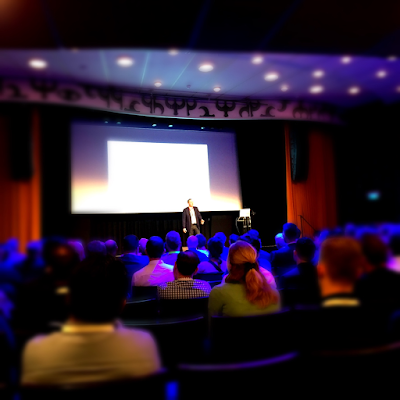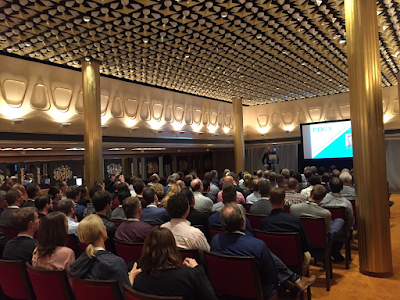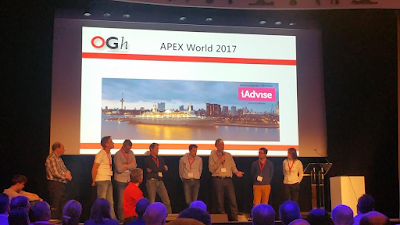Last week the SS Rotterdam was the beautiful location of the largest gathering of APEX Developers worldwide. With around 380 (!) attendees a new high was set. And they came from all over the world : I spotted people from The Netherlands, Belgium, Switzerland, Austria, Croatia, Germany, Denmark, Norway, UK, Ireland and the USA. And I even might have missed one or two ….

The event started with a presentation by the “father of APEX”, Mike Hichwa, talking about "Oracle APEX Past, Present and Future”. Of course everyone is curious what the APEX future might bring: Friendly URL’s, automated testing, more JSON, concurrent APEX versions, third party Oauth 2 authentication (think Facebook, Google), APEX app diff and more, a lot more, REST capabilities. And now we have to wait for APEX 5.2 … and that might take a while!
After this keynote, the conference split up in three tracks. After the coffee break I returned to to big theatre where Geertjan Wielenga talked about "Finally Javascript is easy, with Oracle JET”. I do like JET, but I am not sure all attendees shared Geertjan’s view. They probably were more convinced that APEX is way easier than JET....
Next on stage, the last before lunch, was Alex Nuijten talking about "JET Charts in the world of APEX”. It was a very nice intro into the world of JET charts and Alex showed some peculiarities you have to be aware of. For instance, if you have multiple series, make sure all your queries return the same number of rows and in the same order. Or - as Alex is promoting - release your inner SQL Ninja and use the SQL power to get a proper result in one pass!
After a very good lunch (the quality of the food and drinks was a lot better than I have seen at other conferences, kudos for the organisation!), it was time for my first session, "A Deep Dive into APEX JET Charts”. In this session I am trying to convince the audience that looking into the JET documentation is really worthwhile: with just one or two lines of JavaScript you can add a whole new user experience layer to your pages: much more interactive and dynamic! And for the JET components that are currently not exposed in the APEX Builder, you can create a plugin. Not that hard either, a few lines of PL/SQL, a couple lines of JavaScript and a SQL statement can do the trick! I hoped people liked it. I did get very positive feedback of Geertjan, who is the Product Manager of JET, that he didn’t know it was that easy to modify or incorporate JET Charts in APEX!
 After my session I went to one of the other rooms 4 decks lower to listen to Matt Nolan. He was "Unlocking the power of the APEX plugin architecture”. Compared to previous performances Matt did an excellent job! I don’t know if the attendees will start developing plugins en masse, but it didn’t look too complicated (to me)!
After my session I went to one of the other rooms 4 decks lower to listen to Matt Nolan. He was "Unlocking the power of the APEX plugin architecture”. Compared to previous performances Matt did an excellent job! I don’t know if the attendees will start developing plugins en masse, but it didn’t look too complicated (to me)!
The last keynote of the day was another JET Charts session, "Advanced Charts in APEX 5.1 and beyond” by Hilary Farrell. Inevitably there was some overlap with Alex’ and my session, but also enough new stuff (and around ⅔ of the attendees probably had missed those sessions anyway). Hilary showed some cool examples how to chance the look of the chart or add functionality by just a few lines of Javascript. And in APEX 5.2 … we will get upgraded jQuery (3.x) and jQuery UI (1.12.x) libraries and the latest and greatest version of JET (probably 3.x).
 Because a presentation of Uber was cancelled there was an "Ask the experts panel” added to the agenda. Three of the seven experts are member of the SMART4Apex coöperation, but to be honest, most questions were addressed to and answered by Mike. As SMART4Apex we delivered seven (7!) presentations, enough to fill one of the three tracks for both days...
Because a presentation of Uber was cancelled there was an "Ask the experts panel” added to the agenda. Three of the seven experts are member of the SMART4Apex coöperation, but to be honest, most questions were addressed to and answered by Mike. As SMART4Apex we delivered seven (7!) presentations, enough to fill one of the three tracks for both days...
After this extra session, it was time for drinks and dinner. And because the weather was absolutely fabulous, we could enjoy it all on deck while watching the sun set over Rotterdam.
A great end of a fantastic first day!


Comments